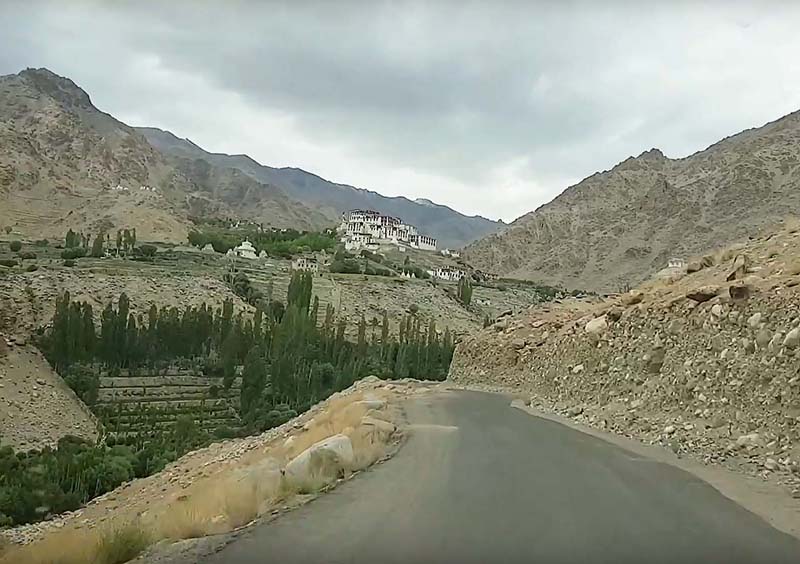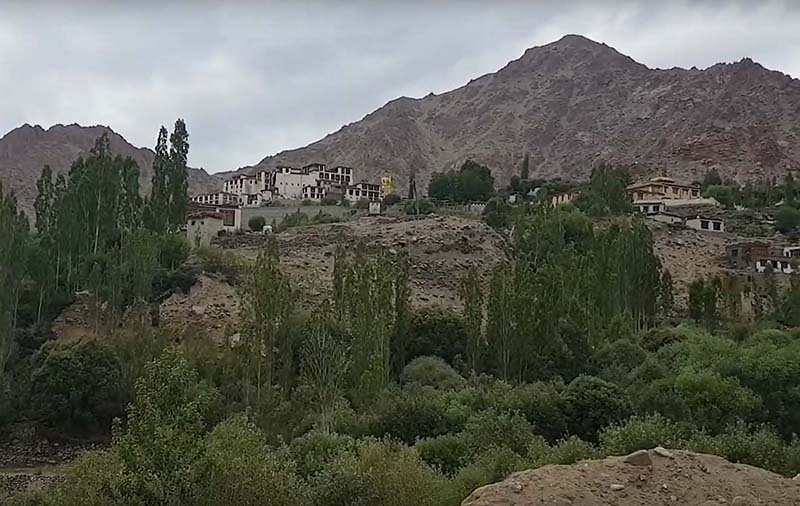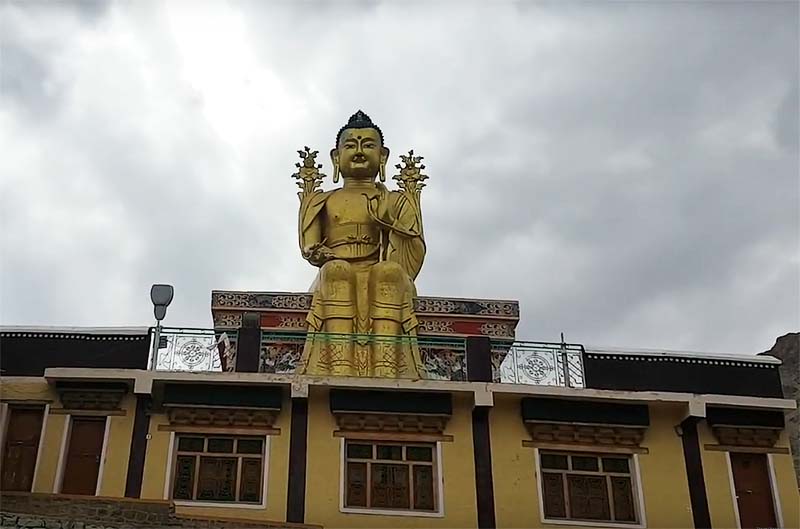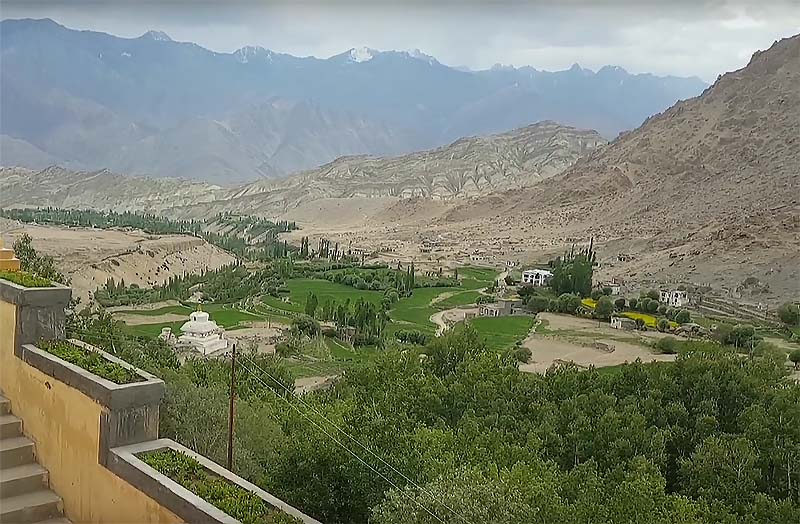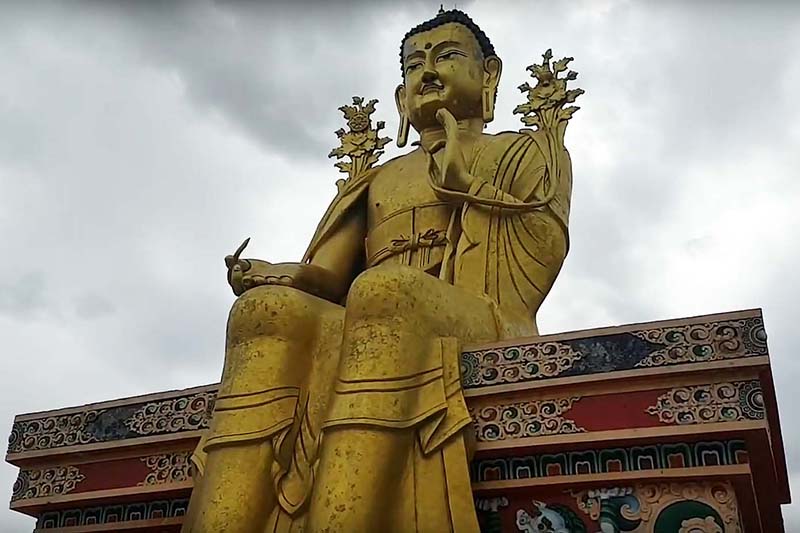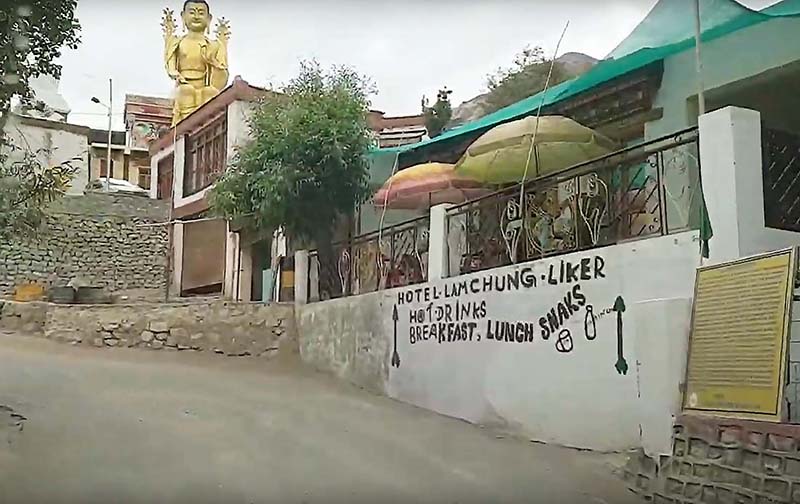One of the top attractions that drive tourism in the Leh Ladakh region is its ancient and beautiful monasteries. Some of these monasteries are large and very well-known while a few others are small and located in remote villages. One thing that is common among all of them, however, is that they are all equally beautiful and serene. One such monastery that I would like to talk about in this article is Likir Monastery.
Likir is a small village located about 55 kilometers from Leh town on Srinagar Leh Highway. This is where the monastery is located and is also named after the village. The name Likir means “The Naga-Encircled”, and it represents the bodies of the two great serpent spirits, the Naga-rajas, Nanda, and Taksako. The monastery is also known as Klu-Khyil Gompa where the name Klu-Khyil means ‘Water Spirits’.
I was recently on a 2-month-long road trip to Ladakh and on the 37th day of the trip, we visited Likir Monastery. The post below is a brief narration of our visit and also provides several necessary details on how a trip to this small village can be planned. To read the previous parts of the travelogue, please follow the links below.
Journey So Far:
- Murgi Waterfall & Ensa Gompa – Day 33
- Nubra Valley to Pangong Lake via Shyok Road – Day 34
- Pangong Lake to Leh via Changla Pass – Day 35
- Leh Hall of Fame – Day 36
- Zorawar Fort – Day 36
- Gurudwara Pathar Sahib – Day 37
- Sangam Point – Day 37
For a more visual presentation of these details, you can also take a look at the YouTube video below that I shot during our visit.
About Likir Monastery
The Likir Monastery was first built in the year 1065. The original structure was later destroyed in a fire and then constructed again in the 18th century. It sits on top of a small hill outside the village in a very picturesque location, at an altitude of 3,700 meters.
The Gompa is built in a fort-like style and is located at the highest grounds, surrounded by agricultural fields on the lower grounds. The main complex consists of a temple, assembly hall, monk’s quarters, and other rooms used for kitchen and dining.
Its location and architectural style are of a well-fortified, compact, and strategically sited Monastery that has been built and rebuilt over a period of time to keep its occupants safe from invasions and attacks.
The monastery is perhaps best known for its 25 ft. (7.6 meters) gold-covered Buddha statue. It is now home to about 120 monks and also runs a small school that educates the children from nearby villages. The annual festival of Dosmoche is held here in February each year.
The village seems a little out of the way now but in ancient times, it used to be on a major trade route that traveled via Tingmosgang, Hemis, and Likir to Leh.
Also Read: How to Plan a Trip to Leh Ladakh – A Complete Travel Guide
Day 37 – Sham Valley Tour
It was the 37th day of our road trip to Ladakh when we visited the Likir Monastery. The overall plan was to go for a tour of Sham Valley, a destination in Ladakh that is still somewhat offbeat and doesn’t receive as many visitors.
Sham Valley is located a little ahead of the village of Likir, on the right side of Srinagar Leh road, at a distance of about 70 kilometers from Leh. It is a wide valley that consists of several small villages like Saspochey, Suspol, Bazgoo, Uley, and Hemis Shukpachan.
A tour of Sham Valley can be done in the form of a full circuit. From Leh, you will start driving towards Kargil on the Srinagar Leh highway. Tourist attractions like Magnetic Hill, Gurudwara Patthar Sahib, and the Indus Zanskar River confluence will all fall along the way. For more details, you can take a look at How to Plan a Trip to Sham Valley.
So we planned that we would take breaks at Gurudwara Pathar Sahib, Magnetic Hill, and Sangam Point. From there, we will continue to Sham Valley and drive around in a complete circle, exiting once again on the Srinagar Leh road. On our way back, if time allowed, we could also cover the monasteries of Alchi and Likir.
Without a doubt, this was going to be a long tour covering a lot of places. For us to complete the tour without rushing, we would need at least 12 to 13 hours. This needed an early start from Leh, as early as possible.
Leh to Likir Monastery
So we woke up at around 6 am. After a light breakfast, by 7 am, we drove out of the hotel and started our Sham Valley tour. The first destination of the day was Gurudwara Pathar Sahib.
We reached the Gurudwara in 20 minutes and spent about an hour there. We offered prayers and then had some delicious Maggie in the early morning Langar followed by some tea. After that, we continued our journey. We drove for another 4 kilometers and reached our next destination – the Magnetic Hill of Ladakh.
We spent about 30 minutes at Magnetic Hill and after a short drive, were soon standing at Sangam Point – the spot where the Indus and Zanskar Rivers merge into each other. I have talked about this in the previous part of the travelogue which I would request you to take a look at for more details.
After Sangam Point, the plan was to drive straight to Sham Valley and visit Likir Monastery on our way back. We continued our journey and crossed the villages of Nimmu and Basgo but somewhere along the way, we took a wrong turn.
Likir Village
After about 50 kilometers from Leh, we came across a bifurcation. The main Srinagar Leh Highway continued to the left and to the right, a narrow road bifurcated toward the mountains. I knew that this was the one that we were to take to get to Sham Valley and we turned right.
However, after about 2 kilometers, the road bifurcated again. One road went straight ahead and the second one went to the left. I wrongly assumed that the road straight went to Sham Valley and the one to the left must be going to some village. So we continued straight and this is where we made the mistake.
After a while, I started to notice a small village in the distance and soon realized that we were going toward Likir Village. We should have instead turned left to go to Sham Valley. The road we stayed on brought us to Likir. Nonetheless, Likir was anyway on the plans for the day so it didn’t matter that we were going to visit it first.
A little after we took this road, we crossed an Orange (Golden Colored) cemented gate and started noticing a lot of small stupas as we got closer to the village.
There are two things that you will see from the distance, the monastery and the village on a hill and the agricultural fields surrounding it. The patches of green in the barren brown mountains of Ladakh look like a sight for sore eyes. A little while later, we crossed another golden-colored gate and finally entered the village of Likir.
Likir Monastery
Vehicles are only allowed until a certain point. You will leave your cars or motorcycles a little outside the monastery and will have to walk the rest of the distance. The gold-covered Buddha statue too can be seen from a distance and looks magnificent.
As you climb up the stairs and reach the roof of the monastery where the statue is located, you will be offered a great view of the surrounding mountains, the village, and the fields. The white stupas on top of the hills around the village look quite beautiful.
There is a small restaurant outside the monastery and a few boards making tourists aware of the accommodation choices in the monastery. There is an entry fee of Rs. 50 per person to enter the monastery. We bought the ticket, climbed a small set of stairs, and entered the monastery.
Architectural Style
Likir Monastery expanded in the 15th century. This was a time when the monasteries in Ladakh and Tibet commanded and controlled the region, land, and agricultural produce. This would often lead to conflicts with rival sects of monasteries for political and material control over the region.
This is why the monasteries were built like forts, with thick peripheral walls, and at a strategically selected high altitude location; to protect its inhabitants and wealth from rival attacks. Though the overall layout has changed drastically over time, you will still clearly see that Likir must have been a classic example of such a fortress-type monastery.
Agricultural fields surround the small hill on which the village and the monastery are built. The main Monastery temple is located at the highest point followed by Monk’s residence just below it and the village houses after that on the lower slope.
Also Read: Ladakh Checklist: Things to Carry for Leh Ladakh Trip
Exploring the Monastery
There are two assembly halls in the monastery, known as Dukhangs. The older Dukhang has six rows of seats for the lamas and a throne for the Head Lama of Likir. It is decorated with statues of Bodhisattva, Amitabha, and three large statues of Sakyamuni, Maitreya, and Tsong Khapa.
Besides the statues, the Dukhang also has glass-fronted bookcases containing several rare books and pictures of Sakyamuni and Likir’s guardian deity.
The newer assembly hall (which also is 200 years old) has a statue of Avalokitesvara with 1000 arms and 11 heads. The left wall has paintings of the 35 Confessional Buddhas while the right wall has an image of Sakyamuni with two of his chiefs by his side.
The verandah is covered with ancient and beautiful Thangka paintings. There is a large and rare Jupiter tree in the courtyard. The monastery also houses several old manuscripts, a notable thangka collection, old costumes used for Cham dances, and earthen pots.
The room of the main Lama has thangkas and images of lamas and the 21 manifestations of the White Tara. The Gonkhang room too contains beautiful thangkas of the divinities.
The main prayer hall of the monastery has seats allocated and reserved for both the Dalai Lama and his brother, Likir’s honorary head lama. There is also a small monastery museum on the rooftop that you can visit. It is just a tiny one-room museum that has on display some Buddhist artifacts, literature, and ancient Thangkas.
The top attraction of the monastery, however, is the 25 ft. high gilded gold statue of Maitreya Buddha, sitting on the roof of the monastery. It was completed in the year 1999 and is really a marvel to look at.
Festivals in Likir Monastery
The annual festival of Dosmoche is celebrated at the monastery from the 27th day to the 29th day of the 12th month of the Tibetan calendar. This is sometime in the month of February as per the solar calendar. You can check the dates in THIS POST which contains dates of all festivals celebrated in Ladakh.
How to reach Likir Monastery
Reaching Likir Monastery is not difficult at all. The village is located near Leh town and is very well connected with a good motorable road. From Leh, it is a total drive of 55-56 kilometers which will take you a couple of hours at most.
From Kargil, Likir is about 170 kilometers and will easily take 5-6 hours to complete. Please note that to explain the information below, I am assuming that you have already arrived at Leh town and now want to plan a visit to Likir from there. If you want to know about getting to Leh as well first, please read How to reach Ladakh by Road, Bus, Air, and Train.
By Road
The best and easiest way would, of course, be by your own vehicle. The entire stretch between Leh and Likir is marked by numerous tourist attractions and the overall landscape as well is very pleasing. You will be driving right next to the Indus River and will even get to see its confluence with the Zanskar River.
If you were traveling by your own car or bike, then I would recommend taking an early start from Leh. Make it what is commonly referred to as a Sham Valley tour. Drive all day long from one tourist spot to another and return to Leh by evening.
Also Read: How to Plan a Trip to Ladakh with family
By Bike
If you, however, arrive in Ladakh by public transport, either by Air or a Bus, then renting a motorcycle will be a good, convenient and cost-effective mode of travel. You can either rent a motorcycle like Royal Enfield or an automated bike like Activa.
Even if you do not want to rent one for the entire duration of your trip, a bike for a day for Sham Valley will be a good idea and can add a different experience to your overall trip. For information on how much you will pay, please read Leh Ladakh Motorcycle Rental Rates.
By Bus
Unfortunately, there is no direct bus available from Leh that goes all the way to Likir Village. You will have to board a bus going towards Lamayuru, Kargil, or Srinagar and get down near Likir Road. For the last 4 kilometers, you can hitchhike if you come across another vehicle or will have to walk the rest of the way. For information on the bus routes, please read Leh Ladakh Bus Schedule and Timings.
By Private Taxi
This may cost you a little but it will be the easiest and most comfortable way to travel in Ladakh. You will cover the same route I explained above, visit the same places and if you have time in hand, may even go as far as Lamayuru. Please read Leh Ladakh Taxi Rates to read about how much it will cost you.
Shared taxis will be another best way to travel. These are available from the Bus stand itself and are more frequent than a Bus. Just reach the Bus stand in the first half of the day and board any cab traveling towards Lamayuru, Kargil, or Srinagar.
Another mode of travel (and the cheapest one actually) is hitchhiking. This may not be an option in the off-season but between May to September, you will find a lot of people traveling on the route. Anyone going towards Likir will be happy to give you a ride to the village. Someone in a car may not be willing to pick you up but a biker riding solo will definitely do.
What to See in Likir
Below is a list of places or things that can be considered tourist attractions in Likir.
- Natural Beauty
- Likir Gompa
- Buddha Statue
- Monastery Museum
- Amazing Landscape
- Serenity
- Gurudwara Patthar Sahib
- Indus Zanskar Confluence
- Magnetic Hill
And that is that. Likir is really a tiny village and as such, there is no long list of tourist attractions here. The place is best known for its monastery and the grand Buddha statue that we just discussed. Other than that, it is just natural beauty, stunning landscapes, and tranquility that you can enjoy here.
Before you reach the village, however, you will pass through 3 of the most famous tourist attractions of Ladakh. The first one is the sacred Gurudwara Patthar Sahib, located at a distance of 23 kilometers from Leh. It is among the highest Gurudwaras in the world and commemorates Guru Nanak’s visit to Leh Ladakh. Take a break, spend some time at the Gurudwara, and pay respect.
After the Gurudwara, you will arrive at the famous Magnetic Hill. The spot is famous as a phenomenon where your car will move uphill on its own, with its engine turned off. Hard to believe? It is true though. To know more, please read The Mysterious Magnetic Hill of Ladakh.
After Magnetic Hill, you will reach the confluence of the Indus and Zanskar Rivers, a stunning sight where these two mighty rivers merge into each other and then continue flowing towards Kargil. It is a great spot to click some beautiful selfies with a stunning landscape in the backdrop.
You will also cross the beautiful villages of Nimmu and Basgo on the way. The entire drive is very scenic and a tourist attraction in itself.
Where to Stay in Likir Village
The villages of Alchi and Likir are at a lower altitude than even Leh City. Due to this, a lot of people land in Leh and come to these villages for their first night for better acclimatization. To get more details, please read How to Handle Acute Mountain Sickness in Leh Ladakh.
So yes, if you want to stay overnight in Likir, you can definitely do so. There are several homestays and guesthouses in Likir. These are all good-value budget options located in the scenic area up by the Gompa. Just take a walk through the village, find one that fits your budget, and check in.
There is one called Norboo Spon Guesthouse that I know to be good, but it is a little outside the village; near the point where the road to Hemis Shukpachan branches off from Likir Road.
If you want to try a homestay in Likir, then I will recommend one called Old Likir Traditional Farmstay, located near the Gompa. The family that owns it is into farming so their house is surrounded by their agricultural fields, and hence the name farmstay.
As far as I know, Likir Monastery does not allow tourists to stay on its premises, nor do they have the arrangements. You can try talking to the Lamas but I do not think you will be allowed and will have to look for accommodation in a village guest house.
Likir is a good place for camping but there are no campsites here. If you were carrying your own camping gear, then you can pitch your tent in the surrounding fields. Do not however do so without taking permission. Just talk to the locals and pay them a little to give you a spot.
Mobile Network in Likir
BSNL has the widest coverage in Ladakh followed closely by Airtel and Jio. The thing that you should know about mobile connectivity in Ladakh is that only postpaid connections work here due to security reasons. If you had a prepaid phone, it would be as good as a paperweight.
If you were carrying a postpaid connection, you would get connectivity with both BSNL and Airtel in Likir. In terms of data, you can hope to get connected with Airtel but there will be no internet with BSNL. Please note that even in terms of network coverage, the quality of the connection and voice calls will not be that good.
Best time to visit Likir
There are two points of view if we talk about the best time to visit Likir Village and the monastery. On an overall basis, June to September is the best time to visit Ladakh and will also apply to Likir. The weather at this time is very pleasant and perfect for tourists.
Srinagar Leh Highway as well as Manali Leh Route will both be open and reaching Ladakh will not be difficult. All hotels, guest houses, and tourism-related activities too will be open during this period.
If you, however, wanted to know about the monastery, the local culture, and Buddhism, then a better time would be to visit around the Dosmoche festival in February.
But please note that the winters in Ladakh are extremely harsh with the temperature at night falling several degrees below zero. Manali and Srinagar roads will be closed so you have no other option but to fly into Leh City. The road from Leh to Likir, however, remains open in February as well. To know more, please read How to Plan a Trip to Leh Ladakh in February.
Likir Monastery Timings
The monastery remains open from 8 AM to 5 PM every day.
Likir Monastery Entry Fee
There is no fee for entering the monastery but you will have to pay Rs. 20 for entering the museum.
Conclusion
I hope the travelogue, pictures, and information above on Likir Monastery were of help. If you have any questions, you can contact me on Instagram and I will be happy to answer. You can also consider subscribing to my YouTube channel and asking a question there.

